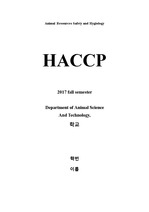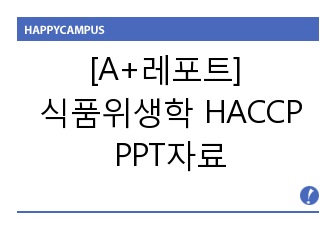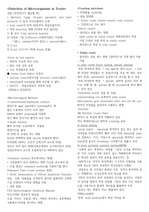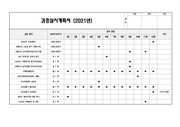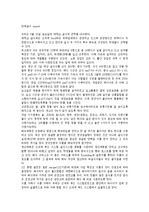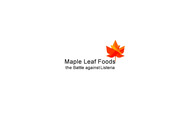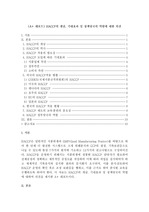

-
미리보기
목차
1.What is HACCP
A. What does HACCAP stand for
B. Building a HACCP system
C. Why use HACCP
D. HACCP is based on seven principles
E. Food Safety management Systems
2. History of HACCP
3. Type of Hazards
A. Biological
B. Chemical
C. Physical
D. Others
4. Developing a HACCP Plan
5. Discussion본문내용
What does HACCP stand for ?
HACCP stands for Hazard Analysis Critical Control Point.
This is an internationally recognized system for reducing the risk of safety hazards in food. A HACCP System requires that potential hazards are identified and controlled at specific points in the process.
This includes biological, chemical or physical hazards. Any company involved in the manufacturing, processing or handling of food products can use HACCP to minimize or eliminate food safety hazards in their product.
The HACCP system is a scientific and systematic approach to identify, assess and control of hazards in the food production process. With the HACCP system, food safety control is integrated into the design of the process rather than relied on end-product testing. Therefore HACCP system provides a preventive and thus cost-effective approach in food safety. HACCP attempts to avoid hazards rather than attempting to inspect finished products for the effects of those hazards. The HACCP system can be used at all stages of a food chain, from food production and preparation processes including packaging, distribution, etc. HACCP has been increasingly applied to industries other than food, such as cosmetics and pharmaceuticals.
What does haccp stand for is a very common question, let's go thru it in details There are seven principles of HACCP that need to be used and implemented in any food industry throughout the world. These principles include the following:
참고자료
· http://haccp.kfri.re.kr
· http://haccp.new21.org/
· www.fda.gov/Food/GuidanceRegulation/HACCP
· PRINCIPLES AND GUIDELINES FOR THE CONDUCT OF MICROBIOLOGICAL RISK MANAGEMENT (MRM) CAC/GL 63-2007
· 2. FAO/WHO guidance to governments on the application of HACCP in small and/or less-developed food businesses
· 3. Hazard Analysis and Critical Control Point (HACCP) System and Guidelines for its Application
· 4. Principles for the Establishment and Application of Microbiological Criteria for Foods
· Food and Drug Administration. "(draft) Guide to minimize microbial food safety hazards of fresh-cut fruits and vegetables" (PDF). Retrieved 14 October 2007.
· Jump up^ Food and Drug Administration. "Guidance for Industry: Juice HACCP Hazards and Controls Guidance, First Edition". Archived from the original on 17 September 2007. Retrieved 14 October2007.
· Food Safety and Inspection Service. "FSIS Microbiological Hazard Identification Guide For Meat And Poultry Components Of Products Produced By Very Small Plants". Retrieved 14 October2007.
· Jump up^ United States Department of Agriculture. "Guidance for school food authorities: developing a school food safety program based on the process approach to HACCP principles" (PDF). Retrieved 14 October 2007.태그
-
자료후기
-
자주묻는질문의 답변을 확인해 주세요

꼭 알아주세요
-
자료의 정보 및 내용의 진실성에 대하여 해피캠퍼스는 보증하지 않으며, 해당 정보 및 게시물 저작권과 기타 법적 책임은 자료 등록자에게 있습니다.
자료 및 게시물 내용의 불법적 이용, 무단 전재∙배포는 금지되어 있습니다.
저작권침해, 명예훼손 등 분쟁 요소 발견 시 고객센터의 저작권침해 신고센터를 이용해 주시기 바랍니다. -
해피캠퍼스는 구매자와 판매자 모두가 만족하는 서비스가 되도록 노력하고 있으며, 아래의 4가지 자료환불 조건을 꼭 확인해주시기 바랍니다.
파일오류 중복자료 저작권 없음 설명과 실제 내용 불일치 파일의 다운로드가 제대로 되지 않거나 파일형식에 맞는 프로그램으로 정상 작동하지 않는 경우 다른 자료와 70% 이상 내용이 일치하는 경우 (중복임을 확인할 수 있는 근거 필요함) 인터넷의 다른 사이트, 연구기관, 학교, 서적 등의 자료를 도용한 경우 자료의 설명과 실제 자료의 내용이 일치하지 않는 경우
찾으시던 자료가 아닌가요?
지금 보는 자료와 연관되어 있어요!
문서 초안을 생성해주는 EasyAI
